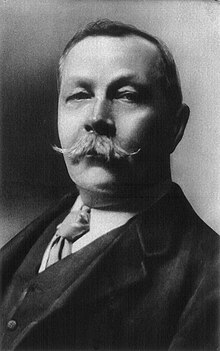About the Book: "The Adventure of the Red-Headed League" is one of the 56 Sherlock Holmes short stories written by Sir Arthur Conan Doyle. It first appeared in The Strand Magazine in August 1891, with illustrations by Sidney Paget. Conan Doyle ranked "The Red-Headed League" second in his list of his twelve favorite Holmes stories. It is also the second of the twelve stories in The Adventures of Sherlock Holmes, which was published in 1892.
About the Author: Arthur Ignatius Conan Doyle was born on 22 May 1859 at 11 Picardy Place, Edinburgh, Scotland. From 1876 to 1881, he studied medicine at the University of Edinburgh, including a period working in the town of Aston (now a district of Birmingham) and in Sheffield, as well as in Shropshire at Ruyton-XI-Towns. While studying, Doyle began writing short stories. His earliest extant fiction, "The Haunted Grange of Goresthorpe", was unsuccessfully submitted to Blackwood's Magazine. His first published piece "The Mystery of Sasassa Valley", a story set in South Africa, was printed in Chambers's Edinburgh Journal on 6 September 1879. On 20 September 1879, he published his first non-fiction article, "Gelsemium as a Poison" in the British Medical Journal. In 1882 he joined former classmate George Turnavine Budd as his partner at a medical practice in Plymouth, but their relationship proved difficult, and Doyle soon left to set up an independent practice. Arriving in Portsmouth in June of that year with less than £10 (£900 today) to his name, he set up a medical practice at 1 Bush Villas in Elm Grove, Southsea. The practice was initially not very successful. While waiting for patients, Doyle again began writing stories and composed his first novels, The Mystery of Cloomber, not published until 1888, and the unfinished Narrative of John Smith, which would go unpublished until 2011. He amassed a portfolio of short stories including "The Captain of the Pole-Star" and "J. Habakuk Jephson's Statement", both inspired by Doyle's time at sea, the latter of which popularized the mystery of the Mary Celeste and added fictional details such as the perfect condition of the ship (which had actually taken on water by the time it was discovered) and its boats remaining on board (the one boat was in fact missing) that have come to dominate popular accounts of the incident. Doyle struggled to find a publisher for his work. His first significant piece, A Study in Scarlet, was taken by Ward Lock Co. on 20 November 1886, giving Doyle £25 for all rights to the story. The piece appeared later that year in the Beeton's Christmas Annual and received good reviews in The Scotsman and the Glasgow Herald. The story featured the first appearance of Watson and Sherlock Holmes, partially modeled after his former university teacher Joseph Bell. Doyle wrote to him, "It is most certainly to you that I owe Sherlock Holmes ... Round the center of deduction and inference and observation which I have heard you inculcate I have tried to build up a man." Robert Louis Stevenson was able, even in faraway Samoa, to recognize the strong similarity between Joseph Bell and Sherlock Holmes: "My compliments on your very ingenious and very interesting adventures of Sherlock Holmes. ... Can this be my old friend Joe Bell?" Other authors sometimes suggest additional influences—for instance, the famous Edgar Allan Poe character C. Auguste Dupin. A sequel to A Study in Scarlet was commissioned and The Sign of the Four appeared in Lippincott's Magazine in February 1890, under agreement with the Ward Lock company. Doyle felt grievously exploited by Ward Lock as an author new to the publishing world and he left them. Short stories featuring Sherlock Holmes were published in the Strand Magazine. Doyle first began to write for the 'Strand' from his home at 2 Upper Wimpole Street, now marked by a memorial plaque. In this period, however, Holmes was not his sole subject and in 1893, he collaborated with J.M. Barrie on the libretto of Jane Annie. Doyle was found clutching his chest in the hall of Windlesham Manor, his house in Crowborough, East Sussex, on 7 July 1930. He died of a heart attack at the age of 71. His last words were directed toward his wife: "You are wonderful." At the time of his death, there was some controversy concerning his burial place, as he was avowedly not a Christian, considering himself a Spiritualist. He was first buried on 11 July 1930 in Windlesham rose garden. He was later reinterred together with his wife in Minstead churchyard in the New Forest, Hampshire. Carved wooden tablets to his memory and to the memory of his wife are held privately and are inaccessible to the public. That inscription reads, "Blade straight / Steel true / Arthur Conan Doyle / Born May 22nd 1859 / Passed On 7th July 1930." The epitaph on his gravestone in the churchyard reads, in part: "Steel true/Blade straight/Arthur Conan Doyle/Knight/Patriot, Physician, and man of letters". Undershaw, the home near Hindhead, Haslemere, south of London, that Doyle had built and lived in between October 1897 and September 1907, was a hotel and restaurant from 1924 until 2004. It was then bought by a developer and stood empty while conservationists and Doyle fans fought to preserve it. In 2012 the High Court ruled that the redevelopment permission be quashed because proper procedure had not been followed. A statue honours Doyle at Crowborough Cross in Crowborough, where he lived for 23 years. There is also a statue of Sherlock Holmes in Picardy Place, Edinburgh, close to the house where Doyle was born.
My Review: This is another entertaining short story involving Sherlock Holmes and his friend Dr. Watson. Wikipedia has a very nice summary on the plot: Jabez Wilson, a London pawnbroker, comes to consult Sherlock Holmes and Doctor Watson. While studying his client, both Holmes and Watson notice his red hair, which has a distinct flame-like hue. Wilson tells them that some weeks before his young assistant, Vincent Spaulding, urged him to respond to a newspaper want-ad offering work to only red-headed male applicants. The next morning, Wilson had waited in a long line of fellow red-headed men, was interviewed and was the only applicant hired, because none of the other applicants qualified; their red hair was either too dark or too bright, and did not match Wilson's unique flame color.
Wilson tells Holmes that his business has been struggling. Since his pawn shop did most of its business in the evenings, he was able to vacate his shop for short periods in the afternoon, receiving £4 a week for several weeks (equal to £370/week today);[1] the work was obviously useless clerical work in a bare office, only performed for nominal compliance with a will, whereupon he was made to copy the Encyclopædia Britannica. Wilson learned much about the subjects starting with the "A" version and looked forward to getting into the "B" section. One morning, a sign on the locked office door inexplicably announced that "THE RED-HEADED LEAGUE IS DISSOLVED."
Wilson went to the landlord, who said that he had never heard of Duncan Ross, the person who managed the league office. The landlord did remember the tenant with scarlet hair and gives him a card which directs Wilson to an artificial knee company. Wilson ends the story with how frustrated he is losing the £4 a week.
Holmes and Watson laugh at Wilson because of the ridiculous situation, but Holmes assures him that by Monday they will solve the case. Wilson leaves after having given the detective a description of Spaulding; Holmes decides to go and see Spaulding, whom Holmes notices has dirty trouser knees. Holmes then taps on the pavement in front of the pawnbroker's shop. With the case solved, he calls Police Inspector Jones and Mr. Merryweather, a director of the bank located next door.
The four hide themselves in the bank vault and confront the thieves when they show up. They are John Clay, who has a long history of criminal activity already, and his helper Archie. Under the alias of Spaulding and Ross, they had contrived the 'Red-Headed League' rigmarole to keep Wilson out of his shop while they dug in the basement, in order to break into the bank vault next door. Although paying Jabez Wilson four pounds a week was expensive, it was a pittance compared to the ill-gotten thousands they were looking to steal from the bank.
Back at Baker Street, Holmes explains to Watson how he solved the case.
I recommend this book to the permanent library of all readers who love a well written mystery story, and in particular a Sherlock Holmes case!
If you read this review, feel free to leave a comment.



No comments:
Post a Comment